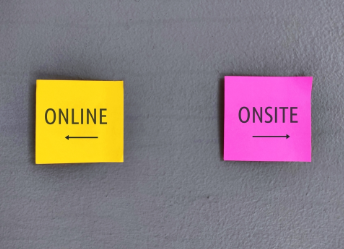by Kenyada J. McLeod

As we press forward into 2024, let us consider another word -- compassion. Many are reconsidering life choices, reprioritizing relationships, and reimagining lifestyles. Remote work policies continue to evolve, and a dream that may have been considered to be impossible for some -- a higher education -- is now more attainable than ever.
Unprecedented
Educational institutions of all kinds were forced to pivot (yet another popular word of the time) into the world of remote learning. Parents felt the pressures of juggling second-grade math, monitoring a child on Zoom, and perhaps their own work responsibilities. While this pivot to remote learning was abrupt, it was also quite informative.
Educators were forced to examine course designs in order to serve learners with limited bandwidth, time constraints, and, of course, physical limitations. College campuses were empty, but learning continued. The modality of learning shifted from sharing a physical space to connecting with learners through remote technologies such as Zoom. We quickly learned that synchronous learning did not have to be limited to sharing the same physical location with a specific classroom configuration.
HyFlex
As the curve began to flatten, doors reopened and masking policies relaxed. There was still a bit of angst for some as it related to sharing physical space and proximity with others. Though the desire for a higher education still persisted, the constraints of a specific time and physical location proved to be unnecessary for some.
How could we possibly address the needs of learners who prefer a physical classroom session, asynchronous learning, and synchronous learning that does not require sharing space with others all at the same time? The short answer is HyFlex.
What is HyFlex?
An instructional delivery modality created by Dr. Brian Beatty as a result of a need to serve learners who "…could not come to class all the time" has evolved into a movement to include professional development for faculty and a preferred method of instruction and learning for some.
HyFlex (or Hybrid Flexible) learning provides one with the opportunity to take ownership of their learning experience by affording the power of choice. In any given week, learners may opt to engage with the class via an in-person classroom, synchronously online via a remote learning technology, or asynchronously online.
Why Embrace Hyflex?
By nature, the HyFlex learning modality automatically infuses compassion and consideration for the human experience. While there are still learners who live on campus and dedicate four or more years to their education, there are also learners with complex lifestyles.
According to the Quality Matters 2023 CHLOE Report, half of the institutions included in the research reported a significant increase in resources dedicated to online or multimodal learning as face-to-face enrollment numbers are steadily declining.
Learners Are Not a Monolith
Responsibilities and life circumstances such as parenting, working one or more jobs, caring for aging parents, and other medical limitations may impede one's ability to pause everything in order to obtain an education.
Educators are servant leaders and must begin to make the shift from sage on the stage to guide on the side. The unequivocal 'side' is meeting the learners where they are. Learner A could be a single mother of three desperately seeking a change in their economic status and has identified an education as the solution. Learner B could be an experienced professional seeking a promotion within their current company. Learner C could be an immunocompromised individual with a wish of earning a degree to make their father proud.
Equity
Learning preferences, life circumstances, varying levels of experience and preparation, stereotype threat, and more all play a role in the level of success obtained by a learner at any given time. The HyFlex modality offers a number of unique benefits to learners:
- Replay and Rewind: In many renditions of the HyFlex modality, all live class sessions are recorded and made available to learners for replay. Many video technologies not only include general playback controls such as play, stop, fast forward, and rewind, but also playback speed and bookmarking. These video controls allow learners to navigate the learning experience in a way that works for them whether it be a full or abbreviated replay.
- Captions and Transcripts: In addition to the general features of video technologies, instructors are strongly encouraged to include captions and/or transcripts for the sake of accessibility. Accessibility is, however, not limited to individuals who are deaf. Captions and transcripts are also beneficial to those with circumstantial limitations. For example, an individual who is in a busy public location may only be able to engage with course content without sound in an effort not to disturb those seated nearby. The captions allow them to read along. Learners may also search transcripts to quickly identify a specific component of a lecture.
- Learner-Centered Experiences: The power of choice allows learners to take ownership of their learning experience. If the learner begins to acknowledge that the difficulty level increases in an uncomfortable way, they may opt to join the class in person or live via Zoom in order to ask questions and receive immediate responses. Learners exercise critical thinking in terms of self-efficacy. If a learner is experiencing car trouble and is unable to make it to class, there are two additional options by which they are able to engage with the class. If a learner becomes ill and would prefer not to pass along a virus, the same options are available.
HyFlex places the learner -- a unique human being -- at the forefront of course design. Learners are engaged in the same content and are able to move through the learning experience together -- in spite of individual circumstances and differences. This compassionate approach to learning design is one to watch, consider, and embrace.
This article is republished from HigherEdJobs® under a Creative Commons license.
